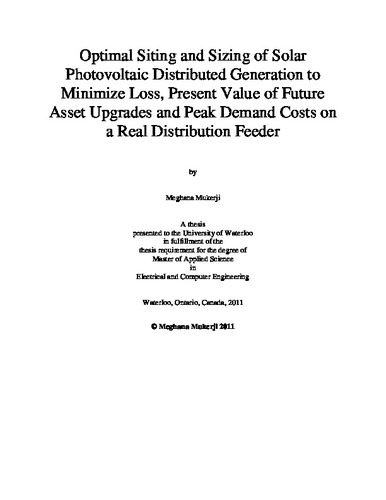| dc.contributor.author | Mukerji, Meghana | |
| dc.date.accessioned | 2011-08-31 17:48:44 (GMT) | |
| dc.date.available | 2011-08-31 17:48:44 (GMT) | |
| dc.date.issued | 2011-08-31T17:48:44Z | |
| dc.date.submitted | 2011-08-19 | |
| dc.identifier.uri | http://hdl.handle.net/10012/6213 | |
| dc.description.abstract | The increasing penetration of distributed generation (DG) in power distribution systems presents technical and economic benefits as well as integration challenges to utility engineers. Governments are beginning to acknowledge DG as an economically viable alternative to deferring investment at generation, transmission and distribution levels, meeting demand growth and improving distribution network performance and security. DG technology is rapidly maturing in Ontario due to government economic incentives promoting connection, specifically, the Ontario’s Feed-In-Tariff (FIT) Program.
Optimal sizing and siting of DG is well researched, traditionally studying the technical impact on distribution system such as real power loss reduction and voltage profile improvement. Equally common objectives studied are the economics of DG installation which are useful for the developer when deciding when and where to install. Although DG represents a “non-wires” solution to network asset reinforcement, the direct economic benefit to the host utility from promoting DG uptake is not fully understood by utility planners and asset managers. Some DG based asset reinforcement deferral work has been performed in the UK and Italy but is mainly at the transmission level and is not part of an overall strategy that could be applied by a utility.
This research presents a comprehensive three stage technique: optimal siting, optimal sizing and financial evaluation of cost savings over a defined planning period to quantify the economic benefit to a Local Distribution Company (LDC) of solar photovoltaic (PV) DG connections on an actual distribution feeder. Optimal sites for PV DG are determined by applying the power loss sensitivity factor method to the test feeder. The objective functions used to determine cost savings consist of loss minimization, asset investment deferral, and peak demand reduction to identify an optimal DG penetration limit. Furthermore, a utility planner can identify an optimal DG penetration limit, encourage uptake at preferred locations that would benefit the LDC, and use the positive impact of DG at existing locations as part of an asset management strategy to prioritize and schedule future asset reinforcement upgrades. | en |
| dc.language.iso | en | en |
| dc.publisher | University of Waterloo | en |
| dc.subject | Distributed Generation | en |
| dc.subject | Solar | en |
| dc.subject | Photovoltaic | en |
| dc.subject | Asset deferral | en |
| dc.subject | optimize | en |
| dc.subject | loss reduction | en |
| dc.subject | peak demand | en |
| dc.subject | losses | en |
| dc.title | Optimal Siting and Sizing of Solar Photovoltaic Distributed Generation to Minimize Loss, Present Value of Future Asset Upgrades and Peak Demand Costs on a Real Distribution Feeder | en |
| dc.type | Master Thesis | en |
| dc.pending | false | en |
| dc.subject.program | Accounting | en |
| uws-etd.degree.department | Electrical and Computer Engineering | en |
| uws-etd.degree | Master of Applied Science | en |
| uws.typeOfResource | Text | en |
| uws.peerReviewStatus | Unreviewed | en |
| uws.scholarLevel | Graduate | en |

